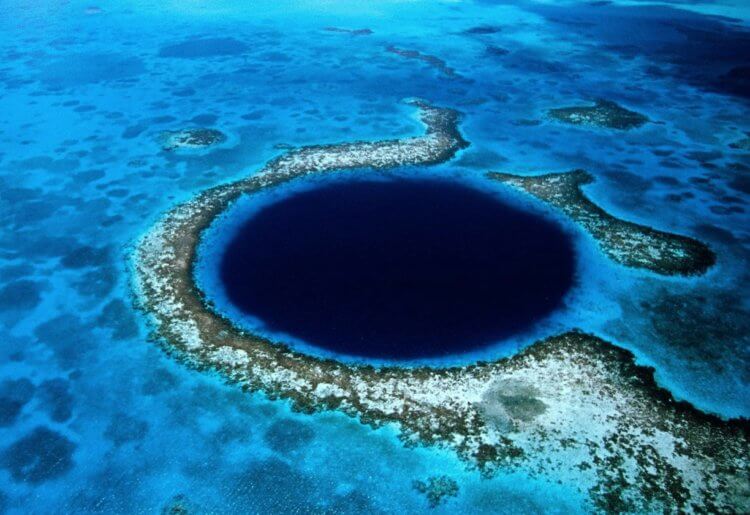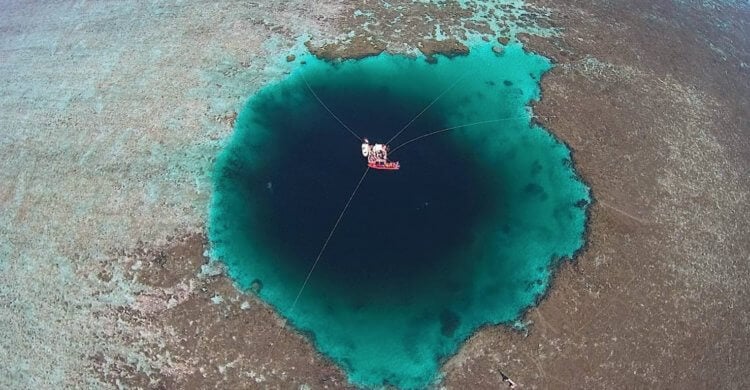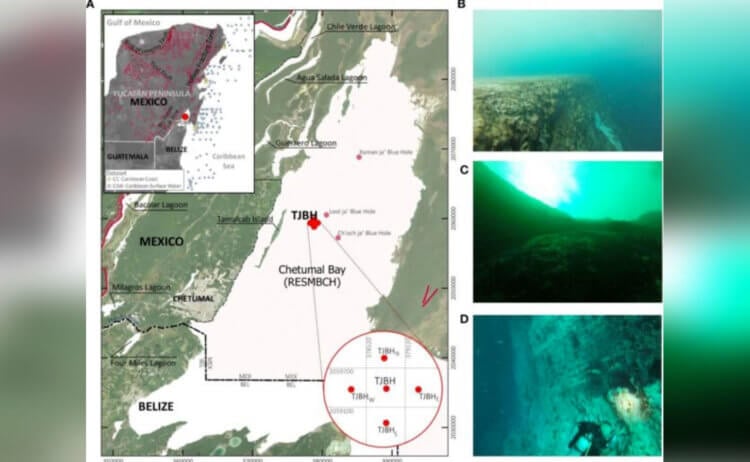About 66 million years ago, an asteroid hit Earth, causing the extinction of dinosaurs and many other ancient animal species. He left behind the 180-kilometer-long Chicxulub crater, which is located on the Mexican Yucatan Peninsula. Scientists believe that an ancient catastrophe greatly changed the geography of the peninsula, making it and its surroundings very different from other parts of our planet. For example, there are a lot of cenotes – failures formed when the arches of limestone caves collapsed. During expeditions, scientists discovered many unique species of animals in these depressions. Also near Yucatan, in the Gulf of Chetumal, there isthe deepest blue hole in the world. Scientists still cannot understand how deep it is, so for now it is called “bottomless.”

Taam Dja Blue Hole near Yucatan. Photo source: livescience.com
Contents
- 1 What is a blue hole
- 2 Dragon Hole in the South China Sea
- 3 The deepest blue hole in the world
- 4 Depth of the Taam Dja blue hole (Yucatan)
< h2>What is a blue hole
Blue holeis a term for a very deep underwater cave or simply a vertical depression. Most often, blue holes are water-filled sinkholes located below sea level. This name comes from the fact that the depressions on top look like dark blue spots around light water. Although it would be more logical if these depressions were called “blue holes.”

Read also:Deep craters form on Earth, into which houses fall
Dragon Hole in the South China Sea
One of the deepest blue holes is located in the South China Sea seas. It is known as the Dragon Hole, but is sometimes called the Yongle Blue Hole after the third emperor of China's Ming Dynasty. According to scientific research, the depth of the Dragon Hole is 300 meters. In this case, the diameter of the hole at the surface is 130 meters, and below the width varies.

Dragon Hole from a bird's eye view. Photo source: travelask.ru
Starting from a depth of 40 meters, the level of oxygen in the blue hole sharply decreases, and after 100 meters it is completely absent. Because of this, the inhabitants of the Dragon Hole prefer to stay on the surface, and there are very few of them – scientists managed to find only about 20 species of living organisms.
Important scientific discovery:20 were found in the depths of the ocean 000 mountains up to 2,500 meters high
The deepest blue hole in the world
For many years, Dragon Hole was considered the deepest blue hole in the world. But now the situation is different – scientists have found that the hole mentioned at the beginning of the article near Yucatan is much deeper. It is called the Taam Dja blue hole and still raises a huge number of questions among scientists.

Location of the blue hole Taam Dha. Image source: sciencealert.com
The Taam Dja blue hole was first discovered in 2003, when a Yucatan resident swam after a fish that swam into his mouth. Scientists have not measured the depth of this hole with a diameter of 150 meters for a long time. But then, with the help of modern technologies, they tried to do this and found out that it was impossible to reach its bottom. The depth of Taam Dja is still unknown, but it is definitely deeper than all known blue holes.
You will be interested:What animal lives deepest underground
Depth blue hole Taam Dja (Yucatan)
Scientists tried to measure the depth of the Yucatan blue hole using sound waves. Typically, once sound waves reach the bottom, they are reflected – this is how researchers study the seabed. But imagine their surprise when, when exploring the Taam Dzha hole, the waves simply were not reflected. According to scientists, the waves were absorbed at a depth of approximately 274 meters. What lies deeper is a very big mystery to science.
It is possible that the sounds of scientific equipment are absorbed by too dense water at depth. A sharp jump in water density at great depths is scientifically called apycnocline. And sailors who travel to great depths simply call it liquid soil. But there is no evidence of this at the moment.

Video about studying the blue hole Taam Dja
In 2023, scientists tried to lower a device into the blue hole to measure the temperature, pressure and electrical conductivity of water. Lowering it to the bottom, the authors of the study unwound all the 500 meters of cable they had and even so they could not reach the bottom. They found out that the hole does not go straight down, but goes slightly to the side. So scientists still have a lot of work to do to figure out the exact depth of Taam Ja.
If you want to discuss science and technology news with someone, check out our Telegram chat. You will definitely find an interesting conversationalist there!
According to scientists, the record-breaking deep hole of Taam Dzha may be home to marine animals still unknown to science. In deep places, new living organisms are indeed often discovered, and they are truly surprising with their characteristics. For example, in 2022, animals with eyes instead of heads were found in the depths of the ocean. It’s hard to believe in the existence of such creatures, but it’s an amazing reality!